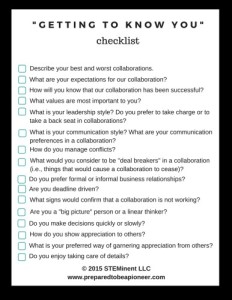The Ultimate Cheat Sheet on Being a Good Team Leader and Member
In a world where people are rewarded for being unique and for standing out in a crowd, being a good team member isn’t always recognized or rewarded. Although people possess differing views about what it means to be a great team member, I’m offering a few tips based upon my experiences as professor and entrepreneur. Although it’s still possible for people to misunderstand your intentions, thinking about your role on a team at the early stages of team formation demonstrates your proactivity and your commitment to the team and its success.
When making decisions, think first about what’s best for the team.
Although it may seem that you are getting the bad end of a deal by placing your team’s needs and considerations before your needs, a good leader always considers the team during decision making. By identifying what is in the best interest of your team, your team members will trust you as their leader and as someone who has their back.
Communicate changes to the team BEFORE disclosing changes to members outside of your team.
This comes back to an issue of trust. There is nothing like being on a team and then finding out information about what is occurring in your organization from someone who is outside of your organization. If this happens and you are the leader, quickly apologize to your team members and identify new ways to enhance internal efforts. If you are a member of the team, determine whether you team leader is receptive to feedback. If you know that you will be persecuted for addressing the issue, determine whether it is worth confronting your leader.
Overcommunicate.
Miscommunication is a big problem on teams. Since many people often enter a team with preconceptions and misconceptions, team members must make sure that they use multiple forms of communication (e.g., verbal and written) to establish group norms and to confirm that everyone is on the same page.
Acknowledge your limitations and weaknesses.
Although acknowledging one’s weaknesses makes a person vulnerable, this level of vulnerability provides a foundation of trust for all team members. Through this professional “nakedness,” members can begin to grow as a team and can identify ways to minimize individual weakness by drawing upon all team members’ personal and professional strengths.
Identify and use professional development tools that will improve your leadership.
Although there are numerous on-line and hard copy tools available to assess one’s leadership and team member skills, one of the best assessment practices is to engage in 360 degree assessments. Such assessments allow all members of a team to offer feedback about their experiences and perspectives. In addition, consider selecting personality or work style assessments that provide individual feedback about team members’ preferences and traits. Debrief results with all team members to determine the best way for team members to move ahead to achieve team goals.
Listen to other team members’ perspectives about areas in which you need to improve.
Once you have completed assessments, engage in “real talk” with team members about areas of strength and weakness. This requires a leader to create an atmosphere in which people can communicate openly. Although it may be difficult to listen to initial feedback, hearing the perspectives of ALL team members is vital to fostering a positive workplace culture. A helpful tip for me is to always remember to separate the personal from the professional (e.g., You can like a person but disagree with her idea and vice versa.)
Allow other team members to do their jobs.
Once you have set all tools in place, give every team member the freedom to create and (yes!) fail. Through this autonomy, the team can observe how team members handle stress and request assistance when they need it. One of the biggest challenges for those of us who like to be in control is to trust others and to delegate. Doing this, however, ensures that team morale remains high and that people feel empowered in their jobs.
In conclusion, being a team member is not always easy. Like any relationship, however, members must take into consideration the perspectives and contributions of others so that everyone wins in the end.
BONUS: I’ve created a FREE downloadable collaborator checklist for you to use before you engage in a new partnership! I guarantee that these questions will help you start your collaboration off in the right way.
——————-
If you enjoyed my post, feel free to share it with others. Also check out my other blog posts, and provide your contact information so that we can stay connected. Like me on Facebook, and follow me on Twitter, Instagram, and Pinterest.


